Abstract
Eighteen patients with liver metastasis or locoregional recurrence of colon carcinoma received locoregional treatment by continuous 5-day infusions of 5-FU. 5-FU blood levels were measured by HPLC every day of the cycle at 8 am and 5 pm for a total of 87 cycles. Twelve patients were given the drug by an intra-arterial hepatic (i.a.h.) route, 3 by the portal vein (i.p.v.) and 3 by an intra-arterial pelvic (i.a.p.) route. These three routes were compared in respect of their relative pre-systemic drug uptake and the effect of dose escalation. Both the i.a.h. and i.p.v. routes, but not the i.a.p. route, resulted in a significant reduction in AUC 0-105 h compared to the i.v. route at the same dose range. Increasing the dose led to a modification in circulating 5-FU levels proportional to the dose for the i.v. and i.a.p. routes. By contrast, for the i.a.h. and i.p.v. routes, systemic drug delivery was significantly elevated, out of proportion with the dose, indicating a saturable process. For the i.a.h. route, increasing the 5-FU dose from 780 to 1000 mg m-2 day-1 caused a drop in hepatic extraction from 0.93 (0.90-0.95) to 0.44 (0.21-0.66). Liver saturation mechanisms were also evidenced by a mean increase of 2.6 times for the circulating drug level during the second part of the cycle as compared to the first part (P less than 0.001). The evolution of 5-FU AUC 0-105 h as a function of the dose was exponential (r = 0.75, P less than 0.001). Local extraction consecutive to i.a.p. was non-existent, implying that this route of drug administration has no potential advantage over classical i.v. infusion.
Full text
PDF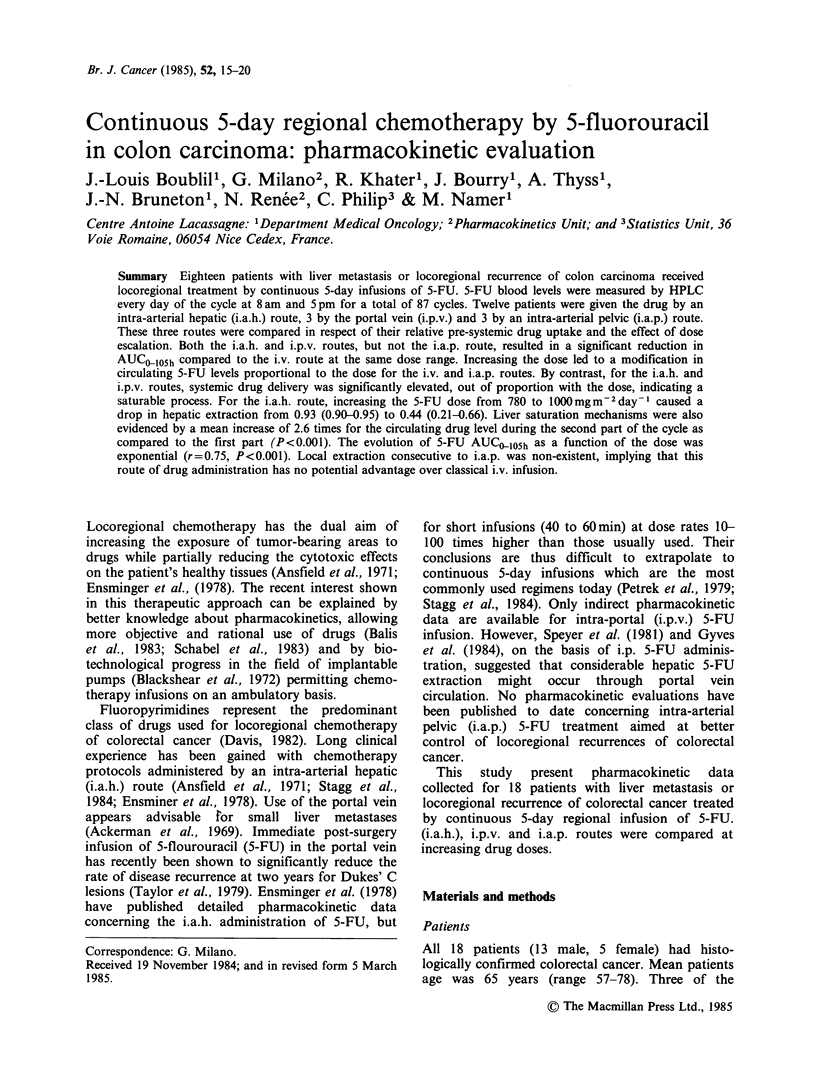
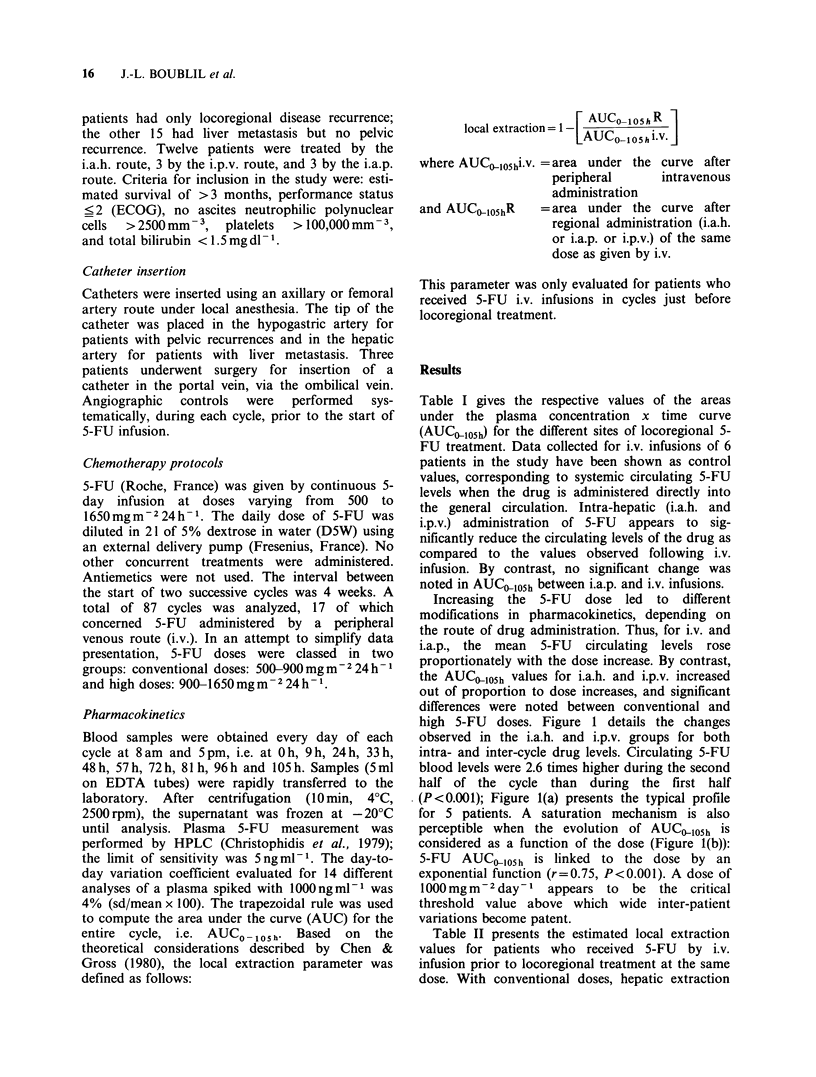
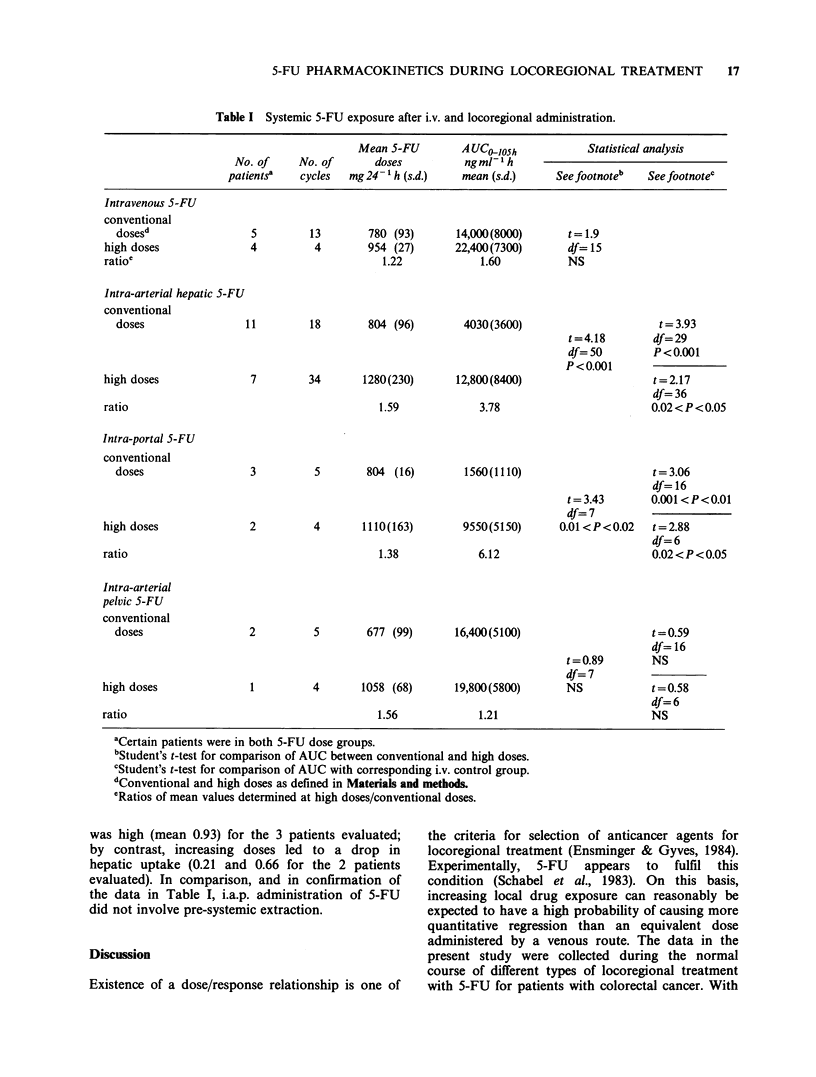
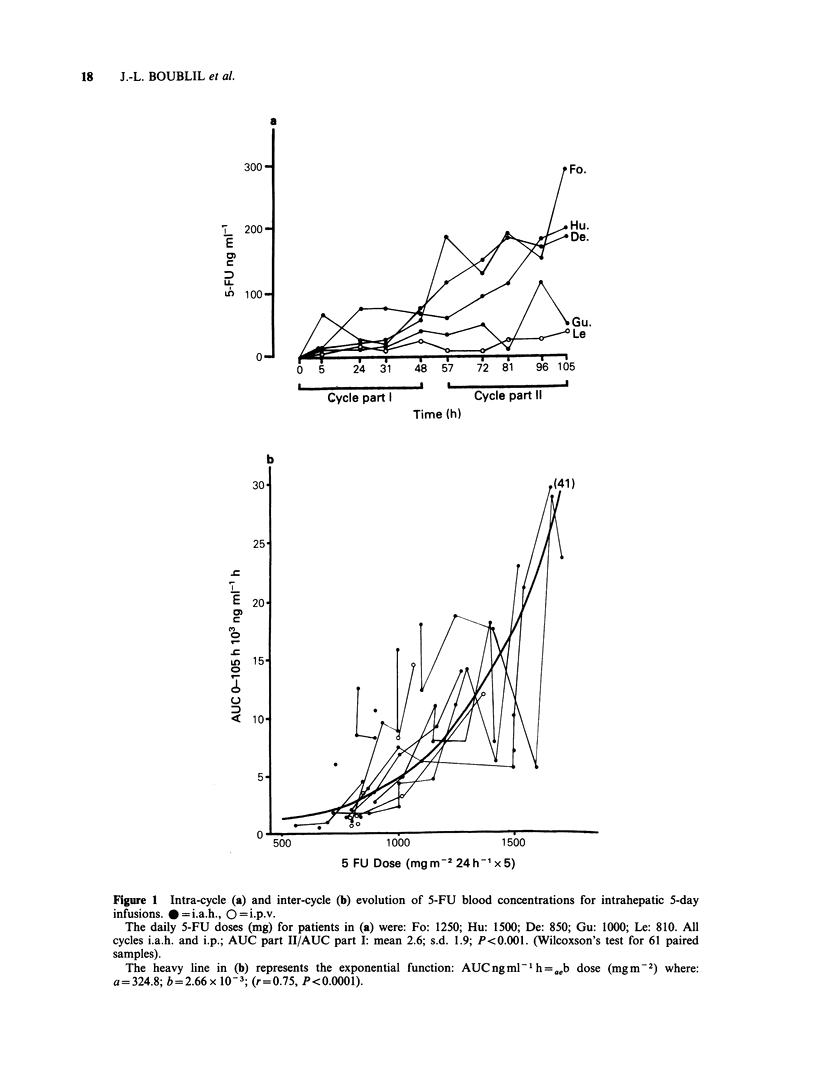
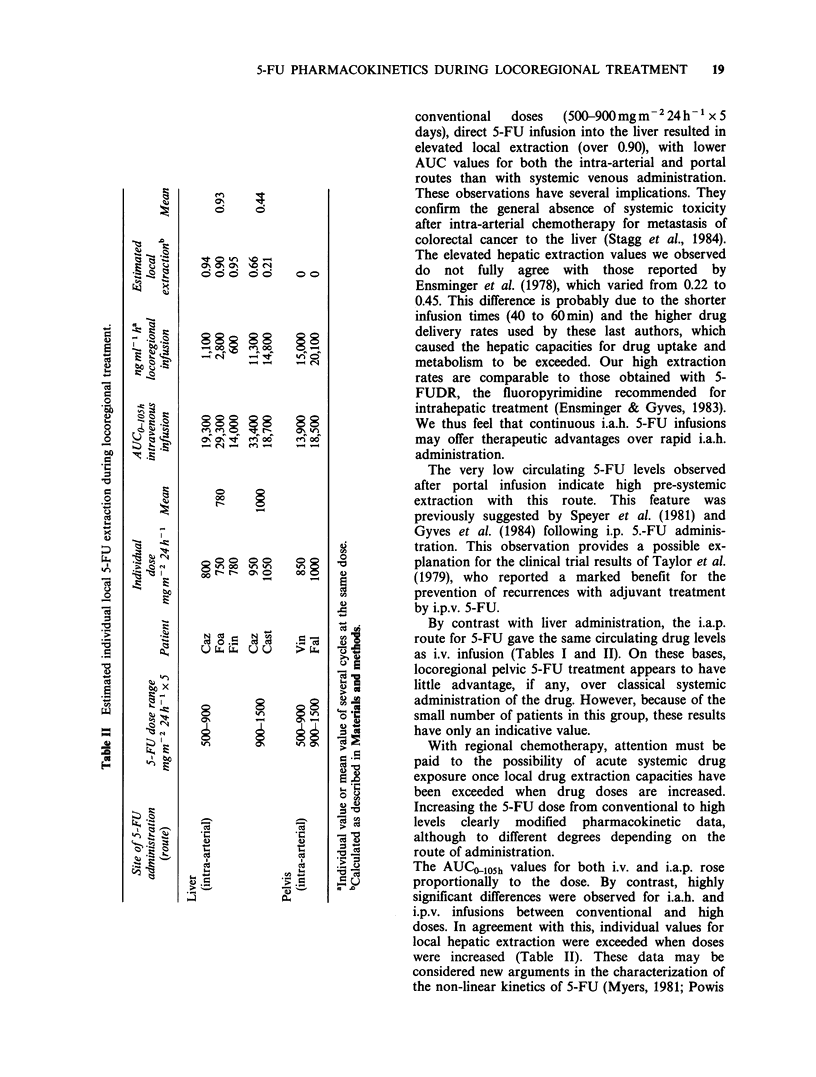
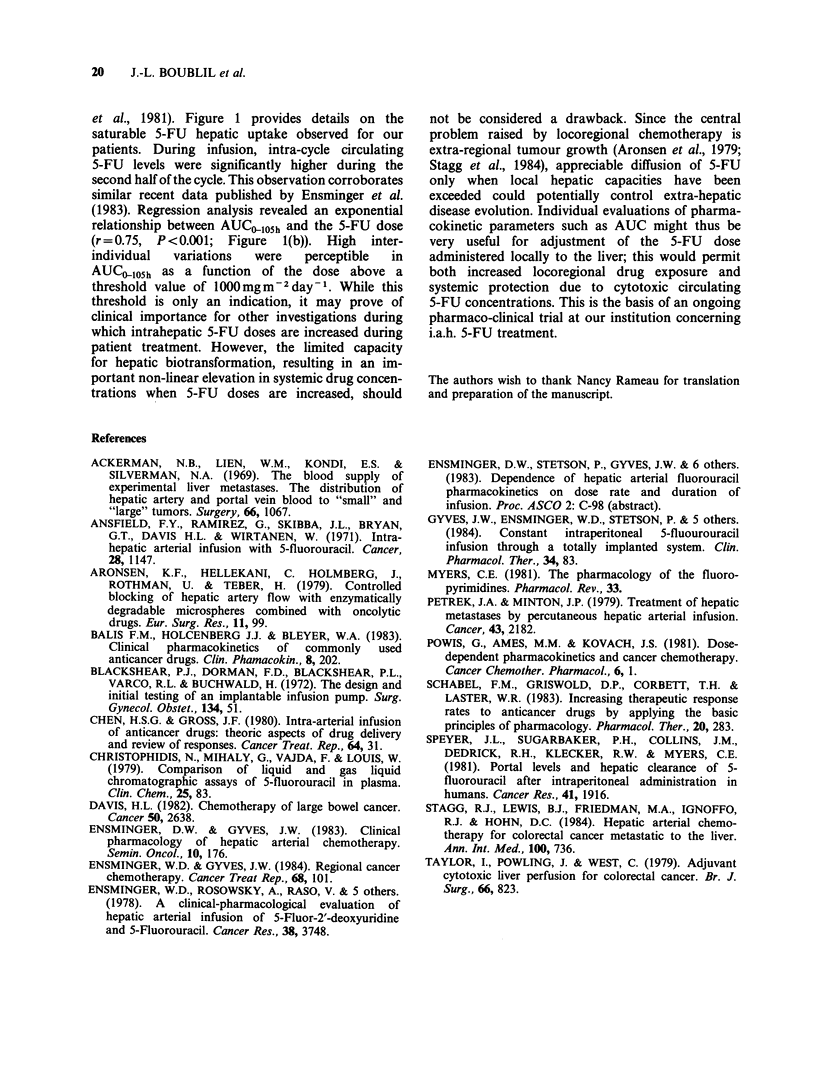
Selected References
These references are in PubMed. This may not be the complete list of references from this article.
- Ackerman N. B., Lien W. M., Kondi E. S., Silverman N. A. The blood supply of experimental liver metastases. I. The distribution of hepatic artery and portal vein blood to "small" and "large" tumors. Surgery. 1969 Dec;66(6):1067–1072. [PubMed] [Google Scholar]
- Ansfield F. J., Ramirez G., Skibba J. L., Bryan G. T., Davis H. L., Jr, Wirtanen G. W. Intrahepatic arterial infusion with 5-fluorouracil. Cancer. 1971 Nov;28(5):1147–1151. doi: 10.1002/1097-0142(1971)28:5<1147::aid-cncr2820280510>3.0.co;2-l. [DOI] [PubMed] [Google Scholar]
- Aronsen K. F., Hellekant C., Holmberg J., Rothman U., Teder H. Controlled blocking of hepatic artery flow with enzymatically degradable microspheres combined with oncolytic drugs. Eur Surg Res. 1979;11(2):99–106. doi: 10.1159/000128056. [DOI] [PubMed] [Google Scholar]
- Balis F. M., Holcenberg J. S., Bleyer W. A. Clinical pharmacokinetics of commonly used anticancer drugs. Clin Pharmacokinet. 1983 May-Jun;8(3):202–232. doi: 10.2165/00003088-198308030-00002. [DOI] [PubMed] [Google Scholar]
- Blackshear P. J., Dorman F. D., Blackshear P. L., Jr, Varco R. L., Buchwald H. The design and initial testing of an implantable infusion pump. Surg Gynecol Obstet. 1972 Jan;134(1):51–56. [PubMed] [Google Scholar]
- Chen H. S., Gross J. F. Intra-arterial infusion of anticancer drugs: theoretic aspects of drug delivery and review of responses. Cancer Treat Rep. 1980 Jan;64(1):31–40. [PubMed] [Google Scholar]
- Christophidis N., Mihaly G., Vajda F., Louis W. Comparison of liquid- and gas-liquid chromatographic assays of 5-fluorouracil in plasma. Clin Chem. 1979 Jan;25(1):83–86. [PubMed] [Google Scholar]
- Davis H. L. Chemotherapy of large bowel cancer. Cancer. 1982 Dec 1;50(11 Suppl):2638–2646. [PubMed] [Google Scholar]
- Ensminger W. D., Gyves J. W. Clinical pharmacology of hepatic arterial chemotherapy. Semin Oncol. 1983 Jun;10(2):176–182. [PubMed] [Google Scholar]
- Ensminger W. D., Gyves J. W. Regional cancer chemotherapy. Cancer Treat Rep. 1984 Jan;68(1):101–115. [PubMed] [Google Scholar]
- Petrek J. A., Minton J. P. Treatment of hepatic metastases by percutaneous hepatic arterial infusion. Cancer. 1979 Jun;43(6):2182–2188. doi: 10.1002/1097-0142(197906)43:6<2182::aid-cncr2820430604>3.0.co;2-n. [DOI] [PubMed] [Google Scholar]
- Powis G., Ames M. M., Kovach J. S. Dose-dependent pharmacokinetics and cancer chemotherapy. Cancer Chemother Pharmacol. 1981;6(1):1–9. doi: 10.1007/BF00253003. [DOI] [PubMed] [Google Scholar]
- Schabel F. M., Jr, Griswold D. P., Jr, Corbett T. H., Laster W. R., Jr Increasing therapeutic response rates to anticancer drugs by applying the basic principles of pharmacology. Pharmacol Ther. 1983;20(2):283–305. doi: 10.1016/0163-7258(83)90042-6. [DOI] [PubMed] [Google Scholar]
- Speyer J. L., Sugarbaker P. H., Collins J. M., Dedrick R. L., Klecker R. W., Jr, Myers C. E. Portal levels and hepatic clearance of 5-fluorouracil after intraperitoneal administration in humans. Cancer Res. 1981 May;41(5):1916–1922. [PubMed] [Google Scholar]
- Stagg R. J., Lewis B. J., Friedman M. A., Ignoffo R. J., Hohn D. C. Hepatic arterial chemotherapy for colorectal cancer metastatic to the liver. Ann Intern Med. 1984 May;100(5):736–743. doi: 10.7326/0003-4819-100-5-736. [DOI] [PubMed] [Google Scholar]


